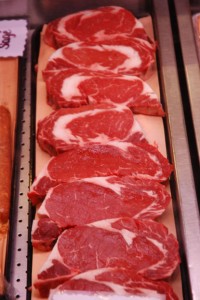I am asked frequently by guests, “What is the best steak?â€Â This question is not easily answered. It is similar to asking someone who sells cars, “What is the best car?â€Â The “best†car depends on a number of factors and will be different for each person. A teenage boy will answer this question differently than a mother with five young children. Someone who lives on a gravel road in the country will have a different set of needs than someone who lives in a city and uses their car for a daily commute. The question should not be, “What is the best steak?â€Â A better question would be, “What is the right steak for me?â€
The single most important factor in determining the right steak for you is the temperature you prefer your steak cooked to. The steak that is best when cooked to well is not the steak that is best when served rare. In fact, most steak aficionados will determine the temperature they want their steak cooked based on the type of steak they order. To understand the reasoning behind this you must understand the differences between the types of steaks on a menu. I addressed this previously in great detail in my beef made easy series.
The easiest way to understand the difference between cuts of meat is to recognize that steaks are muscles from different parts of the cow. The muscles that are used less are softer and more tender. Some of these muscles are so underused that they develop fat deposits that are called “marbling†due to the fact that they look like the white lines in piece of marble. The tenderloin of a cow where filets are cut from contains very little fat, but also is seldom used. The areas around the ribcage where ribeyes and prime rib are cut from are also tender, but contain much more fat.
When a steak is cooked, two very important changes take place. The first change is that the natural moisture inside the steak is cooked out. This explains why a steak that is burnt becomes very dry and tough. The second change that occurs is that the fat within the steak begins to liquefy.  When this occurs, the flavor and moisture within the fat replaces the juices are lost from the meat itself. The fat content of the steak visibly shrinks. While the muscle portion of the steak loses moisture at a very low temperature, the fat shrinks much more rapidly at a higher temperature.
It is also important to know that the temperature you order a steak at (rare, medium, well, etc) refers to a temperature range rather just a color. The color change is a result of the internal temperature of the steak reaching a set level. A rare steak is cooked to an internal temperature of 125F-130F while a medium well steak is cooked to a temperature of 150F-160F. Fat in a steak will begin to liquefy rapidly at between 140F-145F or as it reaches the level referred to as “medium.â€Â As it is allowed to progress further, the fat will shrink further and its flavor will be released.
Once you understand how temperature affects steaks, you can understand why a steak is right for you. If you prefer your steaks cooked rare or medium rare, a filet or tenderloin is the best cut. This is because the tenderloin should have a lean to fat ratio of 93 to 7. If you prefer your steak cooked medium well or well, a ribeye, prime rib, or Delmonico would be the ideal cut. These cuts often have a lean to fat ratio of 80 to 20. A strip, t-bone, or porterhouse is best in the medium temperature ranges. This is because they are generally leaner and most of the fat is found on the edges, making the remaining fat much more manageable to cut around.
There is no universal answer to the question, “What is the best steak?â€Â It depends greatly on the preferences of the individual who will be enjoying the steak. These are helpful guidelines in determining how to order the best steak based on those preferences. There are other factors that contribute to the quality of steaks that have been addressed previously on this blog. This information will help guide you to the right cut and make your next steak dinner far more enjoyable.



